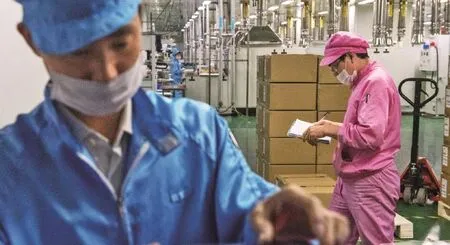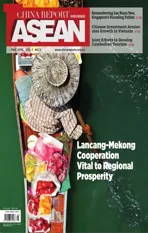Remote Western Region Front Line Of Poverty Alleviation
2016-09-26ByWangFang
By Wang Fang
Remote Western Region Front Line Of Poverty Alleviation
By Wang Fang

Workers in the workshop of BYD (automobile company) in the industrial park of Shangluo
shangluo, a region in Northwest China’s Shaanxi Province, advertises itself as a“Beauty in the Qingling Mountains”. Topographical beauty aside, however, the city faces a daunting battle against poverty as 490,200 of its 2.51 million citizens are surviving below the poverty line.
Located in a relatively disconnected part of the Qingling mountains, Shangluo is one of 14 poverty-stricken areas given special attention by the Chinese Government, together accounting for one percent of the country’s total population living beneath the poverty line.
Adding to the city’s challenges, Shangluo is part of the water conservation area in the middle of the South-to-North Water Diversion Project, responsible for much of Beijing and Tianjin’s clean water. Therefore, ridding Shangluo of poverty while also protecting the local ecological environment represents a huge challenge.
Hard-Fought Battle
In Wangjian village, on the outskirts of Shangluo, a narrow cement road winds its way up a mountain, dotted on both sides by farmers’ houses, with traditional mud huts deserted in the background.
“We used to live in those mud houses,”an elderly villager explained. “No one is living there anymore. Life is much easier now.”
In 2015, per capita annual income of the village reached 11,478 yuan (US$1,765), 2,600 yuan (US$400) more than that of 2012.
“Over the past 20 years, Wangjian Village has changed so much,” said Wang Hongwei,secretary of the Yangyuhe Township’s Party committee, to a group of international MBA students of Beijing Norman University. “All the villagers are living better lives.”
Improvements in income and living standards are owed mainly to the village’s geographic advantages. Since it’s close to a central city (Xi’an), the village has expanded service industries related to the development of Xi’an. These industries include a market place for building materials and automobile parts.
Despite these advances, Shangluo has struggled to hang on to most of its young population. Li Qian, who served as a village official for five years, said that few villagers rely on farming as a source of income these days. Most have opted to outsource their land to large walnut farmers for more cash. the main source of income for most villagers remains seasonal migrant jobs in major cities.
“Only 45 households remain in the village,” Li said. “Most young people have migrated to big cities for work, with the elderly and children leth behind. Many elderly are suffering from chronic diseases like high blood pressure and heart disease. They depend on rural endowment insurance or support from their children.”
In 2016, the Shangluo Government introduced a campaign to combat poverty. Task forces have been assembled for poverty-stricken villages and households to assist villages and households living below the poverty line. So far, 885 such teams have been assigned to households to find ways to improve living conditions and boost annual income.
According to Wang Shenglin, deputy director of Shangluo’s Poverty Alleviation and Development Bureau, by the end of 2015,the Shangluo government had identified 701 impoverished villages, featuring 161,900 households accounting for 490,200 people. Ather identifying the scope of the problem and individual households athected, targeted assistance programs have been established.
Poverty Alleviation Efforts
To raise such a large population out of poverty is a daunting task, filled with serious challenges. Shangluo needs to make full use of regional advantages to succeed.
“We have cultivated the development of featured agriculture as an effective means to add to the income of the poverty population and get them steadily out of poverty,” Wang said. “The featured agricultural products are the ‘Shangluo 8’, namely, chestnut, walnut,mushroom, lamb, free range, aardvark, alpine vegetables and agaric. We are also accelerating the further processing of featured products for added value.”
The development of such unique agriculture cannot go far without incorporating China’s booming e-commerce industry. A variety of agricultural products feature in the recently built e-commerce center at the local industrial park, including walnuts, mushrooms, agaric,chestnuts and tea. these products have been put on sale online, and use of e-commerce firms is growing steadily in the local area.
Additional poverty alleviation measures include innovative financial poverty alleviation models but most involve relocation. Relocation-based measures combine moving villagers to newly constructed towns and building modern industrial parks, farms designed for specific kinds of in-demand agriculture, new style urban communities and competitive scenic spots.
These measures have drawn considerable attention from across China. The target population of this initiative lie in a very mountainous region, such as poverty-stricken households that are scattered cross the Qingling-Bashan Mountains (dividing Shaanxi and Sichuan Provinces). The harsh environment is not suitable for human dwelling. According to Chinese President Xi Jinping, relocating the poor is a key part of targeted poverty alleviation ethorts, allowing the poor to grow steadily more affluent.
According to government statistics, by the end of 2015, Shangluo has built 730 relocation communities, accommodating 92,000 households accounting for 349,000 people, of which 49,000 households came from poverty-stricken areas, accounting for 190,000 people.
But there remains much work to be done. At present, Shangluo has a population of around 400,000 below the poverty line. The local government plans to have all relocated by 2020. Other measures will be taken to support relocation ethorts, such as technical training to help relocated citizens boost their income.
By the end of 2015, Shangluo had raised 469,000 people out of poverty. The area’s overall poverty rate fell from 44.8 percent in 2010 to 25.2 percent in 2015. The per capita disposable income of rural residents reached 7,732 yuan (US$1,190) in 2015, 4,127 yuan(US$635) more than that of 2010.
Improving Weak Links
As Shangluo is key to the water supplies that the mega cities of Beijing and Tianjin depend upon, low-carbon emission development with the implementation of recycling ethorts remain the only option for Shangluo’s economic progress.
To that end, a few weak links remain in Shangluo’s economic development. Due to the large population living in poverty, much of the area’s workforce is low skilled and the area lacks suitable workers in education, health care and science and technology.
Yang Wei, deputy director of Shangluo’s South-to-North Water Diversion Project,lamented the lack of development in Shangluo across all major industries.
“Agriculture here is not great,” Yang said.“Manufacturing is not strong, and the service industry is not prosperous.”
In addition to efforts to protect nearby water supplies, many residents have been forced to change their way of life ather several mountain areas were restricted to prevent deforestation.
“To minimize the impact of human activities on the ecological environment of the drinking-water source areas, the grain plots on slopes steeper than 25 degrees have to return to being forested,” Yang said.
Shangluo used to be fairly dependent on mining, Yang said, but mining has been limited in recent years due to its negative environmental impact.
“Because mining is no longer an attractive option, Shangluo has proposed the idea of low-carbon, recycling-based economic development,” Yang said.
At present, Shangluo has implemented 10 key industrial chains in the local recycled economy, with emphasis across agriculture,manufacturing and the service industries. the value of the Shangluo recycled economy is now worth 70 percent more than the total of local industrial output.
Zhang Yongping, director of Shangluo’s Development and Reform Commission, has stressed innovation as key to Shangluo’s future.
“As the next step, we are going to promote industrial transformation and upgrading, as well as modern featured agriculture and a new type of service industry,”Zhang said. “We will seize the opportunity to build our city into an innovative one with dominant industrial clusters of southern Shaanxi Province, along with popular tourism destinations. Meanwhile, we intend to build our industrial park into a new state high-tech industrial development zone.”
